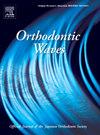Simultaneous distal movement of the maxillary first and second premolars can be achieved by distal movement of the maxillary first molar using a headgear
IF 0.5
Q4 DENTISTRY, ORAL SURGERY & MEDICINE
引用次数: 0
Abstract
ABSTRACT Purpose: The purpose of this study was to investigate the precise effects of a headgear (HG) on the maxillary first premolar (U4), maxillary second premolar (U5), and maxillary first molar (U6). Materials and methods: The participants were divided into two groups: HG group and control group. The HG group consisted of 25 patients who were treated with an HG and maxillary lateral expansion. The control group consisted of 21 patients who received maxillary lateral expansion treatment. Movements of U4, U5, and U6 were measured using cone-beam computed tomography (CBCT). The mesiodistal positions of U4, U5, and U6 were assessed based on the vertical reference plane (VRP) defined by the landmarks of the maxilla. Results: Distal movement of U4, U5, and U6 was observed in the HG group, while mesial movement of U4, U5, and U6 was observed in the control group. Moreover, the positions of U4 and U5 were more distal than that of U6 in the HG group, while the positions of U4 and U5 were less mesial than that of U6 in the control group. The amount of distal movement of U4 and U5 was strongly correlated with that of U6 in the HG group. Conclusions: Simultaneous distal movement of U4 and U5 can be achieved with U6 distal movement using an HG in the early mixed dentition period. Moreover, the amount of distal movement of U4 and U5 was larger than that of U6. Hence, early orthodontic treatment using HG appears to be effective for correcting Class II malocclusion.上颌第一前磨牙和第二前磨牙的同时向远侧运动可以通过使用头套的上颌第一磨牙的向远侧移动来实现
摘要目的:本研究旨在研究头套(HG)对上颌第一前磨牙(U4)、上颌第二前磨牙(U5)和上颌第一磨牙(U6)的精确影响。材料和方法:将受试者分为两组:HG组和对照组。HG组由25名接受HG和上颌侧扩治疗的患者组成。对照组包括21名接受上颌侧扩治疗的患者。使用锥形束计算机断层扫描(CBCT)测量U4、U5和U6的运动。U4、U5和U6的近中位根据上颌骨标志定义的垂直参考平面(VRP)进行评估。结果:HG组观察到U4、U5和U6的远端运动,而对照组观察到了U4、乌5和乌6的近中运动。此外,在HG组中,U4和U5的位置比U6的位置更远,而在对照组中U4和乌5的位置不如乌6的位置近中。HG组中U4和U5的远端运动量与U6的远端移动量密切相关。结论:在混合牙列早期,使用HG可以实现U4和U5的同时远端移动和U6的远端移动。此外,U4和U5的远侧运动量大于U6的远侧移动量。因此,使用HG的早期正畸治疗似乎对矫正II类错牙合是有效的。
本文章由计算机程序翻译,如有差异,请以英文原文为准。
求助全文
约1分钟内获得全文
求助全文
来源期刊

Orthodontic Waves
DENTISTRY, ORAL SURGERY & MEDICINE-
CiteScore
0.40
自引率
0.00%
发文量
0
期刊介绍:
Orthodontic Waves is the official publication of the Japanese Orthodontic Society. The aim of this journal is to foster the advancement of orthodontic research and practice. The journal seeks to publish original articles (i) definitive reports of wide interest to the orthodontic community, (ii) Case Reports and (iii) Short Communications. Research papers stand on the scientific basis of orthodontics. Clinical topics covered include all techniques and approaches to treatment planning. All submissions are subject to peer review.
 求助内容:
求助内容: 应助结果提醒方式:
应助结果提醒方式:


